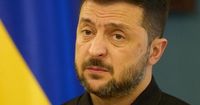On October 1, 2025, the specter of nuclear danger resurfaced in northern Ukraine as a barrage of Russian drones struck the city of Slavutych, severing the main power supply to the decommissioned Chernobyl Nuclear Power Plant. For more than three tense hours, the only thing standing between the world and the remnants of the 1986 disaster was the persistent hum of two emergency diesel generators, according to the International Atomic Energy Agency (IAEA). Though power was ultimately restored, the incident has reignited global anxieties over the safety of nuclear facilities in Ukraine’s conflict zones.
The attack, which Ukrainian officials say involved more than 20 Russian-Iranian Shahed drones, targeted the vital infrastructure that connects Chernobyl to the national grid. As reported by Reuters and confirmed by the IAEA, the New Safe Confinement (NSC)—the massive steel-and-concrete dome built to contain radioactive debris from reactor four—was left without its regular power supply. This forced the site to rely on backup generators, a scenario experts warn cannot be sustained indefinitely.
While the rest of the Chernobyl complex quickly switched to alternative power lines, the NSC remained isolated, its critical cooling and radiation monitoring systems running on emergency fuel. The IAEA stressed, “Nuclear safety cannot depend indefinitely on backups or damaged infrastructure.” The agency’s warning echoed the concerns of Ukrainian President Volodymyr Zelenskyy, who accused Russia of “deliberately creating the threat of radiation incidents” by targeting energy and nuclear-linked facilities. “Every day of Russia’s war, every strike on our energy facilities, including those connected to nuclear safety, is a global threat,” Zelenskyy declared, according to The Washington Post.
The stakes are high. Although Chernobyl no longer produces electricity, the site still stores more than 3,000 tonnes of spent nuclear fuel. These materials require constant cooling and monitoring to prevent overheating or the escape of radioactive dust. Even brief interruptions in power, Kyiv warns, could compromise the systems designed to keep the world’s worst nuclear accident contained.
Radiation levels at Chernobyl have remained stable throughout the recent crises, with no breach of the inner containment shell reported. Firefighters quickly extinguished a small blaze caused by a previous drone strike in February, which damaged the outer cladding of the NSC but left the structure’s integrity intact. According to ABC News, Ukrainian engineers later inspected the dome and confirmed it remained secure.
Still, the frequency and intensity of these attacks have left both Ukrainian officials and international watchdogs on edge. The IAEA has repeatedly called for swift restoration of reliable electricity to all nuclear sites in Ukraine. “Reliance on generators or short-term fixes is fragile,” the agency said, warning that repeated blackouts could blind radiation monitoring systems and undermine the plant’s security.
The vulnerability of Ukraine’s nuclear infrastructure is not limited to Chernobyl. In the country’s southeast, the Zaporizhzhia Nuclear Power Plant—Europe’s largest—has been disconnected from the grid for over a week, also due to attacks. Both Russia and Ukraine have traded blame for the strikes, with Russian President Vladimir Putin dismissing Ukrainian claims as “nonsense” and warning of possible retaliatory measures. “People on the other side must understand that if they continue this dangerous game, they also have functioning nuclear power plants. What would prevent us from responding in kind? Let them think about it,” Putin said, according to BBC.
The situation at Zaporizhzhia is, in the words of Ukraine’s energy ministry, “unprecedented.” No nuclear power plant in the world has operated under such conditions, making reliable forecasts impossible. The facility is currently using emergency diesel generators to run cooling systems for its six shutdown reactors and spent fuel, with the IAEA monitoring closely and urging a return to normal operations as soon as possible.
For residents of Slavutych and the surrounding region, the October 1 attack was a chilling reminder of how quickly the threat of nuclear disaster can return. The city, built to house workers evacuated from Pripyat after the 1986 catastrophe, remains inextricably linked to the fate of the Chernobyl site. As President Zelenskyy pointed out, “The Russians could not have been unaware that a strike on Slavutych would have such consequences for Chernobyl.”
International concern extends beyond Ukraine’s borders. Chernobyl sits just 90 kilometers north of Kyiv and close to Belarus. Any significant release of radiation could have repercussions across Europe and beyond. The IAEA, European Union, and NATO have all called for stronger protection of nuclear facilities in Ukraine, emphasizing that the risks posed by military action near these sites are truly global.
Meanwhile, the war shows no signs of abating. On October 2, Russia launched its largest attack of the conflict, firing 381 drones and 35 missiles at Ukraine’s gas extraction and processing facilities, according to Ukraine’s air force and Naftogaz, the state-owned gas company. “This is deliberate terror against civilian facilities that provide gas extraction and processing for the normal life of people,” said Serhii Koretskyi, Naftogaz’s chief executive. He described the strikes as an attempt to disrupt the heating season and deprive Ukrainians of warmth as winter approaches.
In the midst of these escalating hostilities, a rare moment of relief came with a major prisoner swap. On October 2, Ukraine and Russia exchanged 185 military personnel and 20 civilians each, many of whom had been held captive since 2022. President Zelenskyy announced the return of more than 7,000 Ukrainians since the war began, while Russia’s defense ministry confirmed a similar number of its own soldiers and civilians had come home.
The latest power outage at Chernobyl, though resolved without incident, has left the world on edge. As the conflict grinds on, the risks to Ukraine’s nuclear infrastructure—and by extension, to global safety—remain disturbingly real. The repeated targeting of energy and nuclear sites underscores the urgent need for robust international action and safeguards. For now, the battered steel dome over reactor four holds, and diesel generators keep the lights on. But as officials and experts alike warn, relying on such fragile measures is a gamble the world cannot afford to lose.




